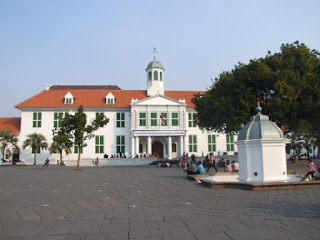 Walking around Indonesia
Walking around IndonesiaIf you want to know the history of the founding of Jakarta, you can visit the Museum Fatahilah.
Fatahillah Museum, also known as the Jakarta History Museum or the Museum of Batavia is a museum located at Jalan Taman Fatahillah No. 2, West Jakarta with area of more than 1,300 square meters.
This building was once a City Hall (Dutch: Stadhuis) which was built in 1707-1710 by order of Governor-General Johan van Hoorn. The building resembles the Dam Palace in Amsterdam, consisting of the main building with two wings on the east and west as well as sanding buildings used as offices, court rooms, and underground spaces are used as a prison.
On March 30, 1974, this building was inaugurated as a museum Fatahillah.
History of Jakarta City
Based on archaeological excavations, there is evidence that the first settlement in Jakarta are in the Ciliwung river. This settlement in the interview comes from 2500 BC (time Neolothicum). The first written evidence is found monument inscriptions issued by King Tarumanegara in the 5th century. Inscription is evidence of religious activity at the time. At the next time around the 12th century this area was under the authority of the government's famous harbor Sunda Sunda Kelapa port.At this time held between the Portuguese trade agreement with the king of Sunda. In the 17th century trade with foreign parties widening, Sunda Kelapa port to Jayakarta change (1527) and later became the Batavia (1619). Japanese people in 1942 to seize power from the hands of the Dutch and the authorities in Indonesia until 1945.
History Building
Jakarta History Museum building was built in 1620 by Governor General Jan Pieterszoon Coen as the second town hall in 1626 (the first town hall was built in 1620 near the East Kalibesar). According to historical records, this building only single-stage and second-level development carried out later. In 1648 the building condition is very bad. Jakarta is very unstable ground and the weight of the building causing the building down from the surface soil. The easy solution is carried out by the Dutch government is not changing the existing foundation, but raise the floor about 2 feet (56 cm). According to a report of 5 pieces of cells that are under the building was built in 1649. In 1665 the main building be widened by adding each of the rooms in the West and East. After that some of the improvements and changes in the building stadhuis and prisons continue to be made up into a form that we see today. Besides being used as stadhuis, the building was also used as the Raad van Justitie''''(judicial council). In 1925-1942, the building was used as the Office of the Provincial Government of West Java and in the years 1942-1945 is used for the collection of logistics office of Dai Nippon. In 1952 this building became the headquarters for the City Command Military (KMK) I, then converted back into KODIM 0503 West Jakarta. In 1968, the building was handed over to the Government of DKI Jakarta, and inaugurated the Museum of History of Jakarta on March 30, 1974. As common in Europe, the courthouse is equipped with a field called''Stadhuisplein''. According to a painting of the money made by the employee VOC'''Johannes Rach "' which comes from the'''Denmark' ', in the middle of the field there is a fountain which is the only source of water for local communities. The water was coming from Pancoran Glodok connected by pipes to the stadhuiplein. In 1972, excavations conducted on the field and found foundation fountain complete with pipes. So with that historical evidence can be rebuilt according to the image Johannes Rach, then created a fountain in the middle of Fatahillah Park. In 1973 the Government of DKI Jakarta re-creating the park by giving a new name is'''Park Fatahillah "' to commemorate the founding Fatahillah commander of the city. And here is information that can help you visit the Museum Fatahilah
Opening Times
Tuesday to Sunday from 09.00 - 15.00 pm
Monday and Holidays Close
Price of admission:
Adult Rp. 2000
Student Rp. 1000
Student / Child Rp. 600
Group of Adult Rp. 1500
Student Group of Rp. 750
Group Student / Child Rp. 500
Groups of at least 20 people.
Address Museum History of Jakarta
Jl. No. Fatahillah Park. 1 Jakarta Barat
Tel (62-21) 6929101, 6901483
Fax. (62-21) 6902387
email: musejak@indosat.net.id
So, Enjoying Walking Around Indonesia




No comments:
Post a Comment